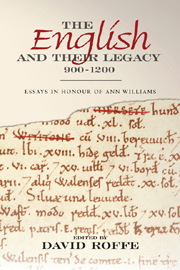Book contents
- Frontmatter
- Contents
- Figures and Tables
- Dedication
- Preface
- Contributors
- Abbreviations
- Ann Williams: a Personal Appreciation
- Life-writing and the Anglo-Saxons
- Meet the Swarts: Tracing a Thegnly Family in Late Anglo-Saxon England
- The Moneyers of Kent in the Long Eleventh Century
- Master Wace: a cross-Channel Prosopographer for the Twelfth Century?
- From Minster to Manor: the Early History of Bredon
- Eadulfingtun, Edmonton, and their Contexts
- The Family of Wulfric Spott: an Anglo-Saxon Mercian Marcher Dynasty?
- The Burial of King Æthelred the Unready at St Paul's
- Eustace II of Boulogne, the Crises of 1051–2 and the English Coinage
- Through the Eye of the Needle: Stigand, the Bayeux Tapestry and the Beginnings of the Historia Anglorum
- Robert of Torigni and the Historia Anglorum
- Invoking Earl Waltheof
- Hidden Lives: English Lords in post-Conquest Lincolnshire and Beyond
- Lordship and Lunching: Interpretations of Eating and Food in the Anglo-Norman World, 1050–1200, with Reference to the Bayeux Tapestry
- The Exchequer Cloth, c. 1176–1832: the Calculator, the Game of Chess, and the Process of Photozincography
- Ann Williams: a Bibliography 1969–2011
- Index
- Tabula Gratuloria
Invoking Earl Waltheof
Published online by Cambridge University Press: 05 April 2013
- Frontmatter
- Contents
- Figures and Tables
- Dedication
- Preface
- Contributors
- Abbreviations
- Ann Williams: a Personal Appreciation
- Life-writing and the Anglo-Saxons
- Meet the Swarts: Tracing a Thegnly Family in Late Anglo-Saxon England
- The Moneyers of Kent in the Long Eleventh Century
- Master Wace: a cross-Channel Prosopographer for the Twelfth Century?
- From Minster to Manor: the Early History of Bredon
- Eadulfingtun, Edmonton, and their Contexts
- The Family of Wulfric Spott: an Anglo-Saxon Mercian Marcher Dynasty?
- The Burial of King Æthelred the Unready at St Paul's
- Eustace II of Boulogne, the Crises of 1051–2 and the English Coinage
- Through the Eye of the Needle: Stigand, the Bayeux Tapestry and the Beginnings of the Historia Anglorum
- Robert of Torigni and the Historia Anglorum
- Invoking Earl Waltheof
- Hidden Lives: English Lords in post-Conquest Lincolnshire and Beyond
- Lordship and Lunching: Interpretations of Eating and Food in the Anglo-Norman World, 1050–1200, with Reference to the Bayeux Tapestry
- The Exchequer Cloth, c. 1176–1832: the Calculator, the Game of Chess, and the Process of Photozincography
- Ann Williams: a Bibliography 1969–2011
- Index
- Tabula Gratuloria
Summary
Earl Waltheof's career has been well summarized. The verdict is that although he achieved short bursts of effective and energetic military action, he was too readily influenced by those around him. As a hero-figure he had limitations, but after his death his name was invoked to promote widely-varying interests both in England and beyond, not only in the generations which followed his death but also intermittently down to the early seventeenth century.
The earliest recorded evidence of the promotion of his name dates from the very beginning of the twelfth century, a generation after his death. Archbishop Anselm wrote two letters in an effort to suppress a tomb-cult being promoted by the nuns of Romsey abbey. One of these letters was addressed to Stephen, archdeacon of Winchester. Anselm ordered him to go to Romsey and order the lady abbess and the nuns in the name of the archbishop, in that of the bishop of Winchester, and in his own name as archdeacon that, if they did not want the archbishop to prohibit them from celebrating the divine office, then neither they nor anyone else must render any honour due to a saint to that deceased man whom they wanted to venerate. They must expel the son of this man from the village and there were to be no further dealings with him. Despite this reprimand the nuns persisted in observing the cult. The archbishop then wrote directly to Abbess Athelitz and her flock, ordering them again under suspension of the divine office to cease from honouring the deceased as a saint, and to expel his son from the vill.
- Type
- Chapter
- Information
- The English and their Legacy, 900–1200Essays in Honour of Ann Williams, pp. 185 - 204Publisher: Boydell & BrewerPrint publication year: 2012



